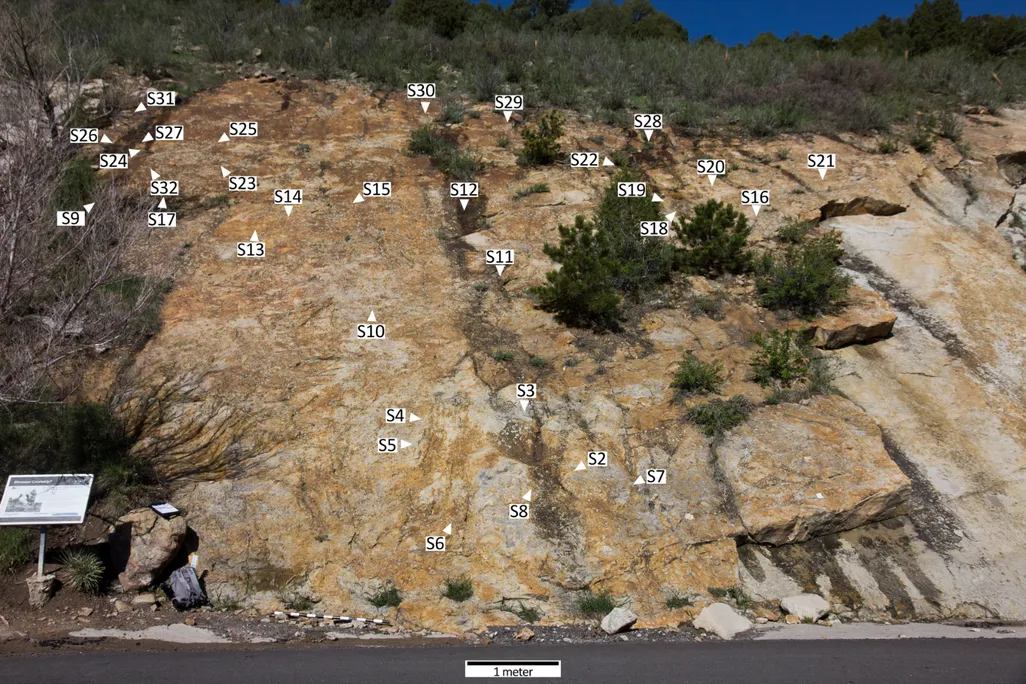Dinosaurs Gathered to Perform Mating Dances With Kicks and Spins at This Site in Colorado—and You Can Go See It for Yourself
Paleontologists have discovered what appears to be one of the largest dinosaur courtship arenas in the world, just 15 miles west of Denver

Roughly 100 million years ago, amorous male dinosaurs congregated in what is now Colorado to strut their stuff in hopes of impressing potential mates.
That’s the scene paleontologists now say played out at Dinosaur Ridge, a protected, fossil-rich site located roughly 15 miles west of Denver. Scientists have discovered dozens of fossilized scrape marks on the ground, which they suggest were made by dinosaur feet during mating rituals that are still performed by some modern birds today.
They describe their findings in a new paper published online in June in the journal Cretaceous Research.
Fun fact: Dinosaur courtship
Several dinosaur species had horns and spikes in arrangements that would not have been very helpful for defense. Instead, paleontologists suggest they might have served to impress mates—and some species might have had showy feathers for that purpose, too.
The work dates back to 2023, when scientists found five fossilized scrape marks on a slope, reports Science’s Taylor Mitchell Brown. Paleontologists suspected the etchings were made by medium-size dinosaurs as they were building their nests, but they decided to conduct additional research to learn more.
State law prohibits anyone from walking atop fossils, so the scientists did the next best thing: They tracked down high-resolution drone photos captured in 2019 by the U.S. Geological Survey. They also snapped their own aerial photos in 2024.
When the team took a close look at the imagery, they saw 35 scrape marks of various shapes and sizes.
“This was a one-of-a-kind find,” says lead author Caldwell Buntin, a paleontologist at Old Dominion University, to BBC Science Focus’ Tom Howarth. “We were extremely excited, and it was a surreal moment looking at the drone imagery for the first time and noticing scrapes pop up all across the screen. It was definitely a ‘eureka!’ moment for me.”
/https://tf-cmsv2-smithsonianmag-media.s3.amazonaws.com/filer_public/b1/4d/b14dd707-3344-4a2b-8625-f6067baa70f4/scrape_1to8_dem_1.png)
Based on the distribution of the marks throughout different rock layers, paleontologists deduced they were made by dinosaurs returning repeatedly to the area over time. Fossil footprints near the site led the scientists to suspect that the marks were made by Ornithomimids, a group of plant-eating creatures that looked similar to modern ostriches, or Acrocanthosaurus, a large, two-legged meat-eater—though they can’t say for sure.
The shape and depth of the marks also revealed some insights about how dinosaurs moved at the site. Some appeared to have been made by the creatures kicking their feet backward one at a time, while others seem to have come from individuals rotating and scraping their claws on the ground, “indicating a counterclockwise or a clockwise turn,” Buntin tells ABC News’ Mary Kekatos.
It’s “kind of like the moonwalk with a little spin,” he adds to Discover magazine’s Sam Walters.
/https://tf-cmsv2-smithsonianmag-media.s3.amazonaws.com/filer_public/7f/1e/7f1ec3e5-0815-458f-ab95-5a0bb7d38372/panel.png)
Together, these findings indicate the area was once a “lek,” an outdoor spot where dinosaurs would have gathered to perform mating dances and courtship displays. Several species of modern birds—which are the descendants of dinosaurs—congregate at leks for the same reason, including greater sage-grouse and great bustards.
“This shows [a] concentration of probably male dinosaurs in a very small area doing their displays, both for territory and also to attract a mate,” says study co-author Neffra Matthews, a researcher who used to work for the Bureau of Land Management but is now retired, to KMGH-TV’s Ethan Carlson. “The females would be able to congregate in a central location around them, so that they would be able to prove dominance and have mate selection somewhat simultaneously.”
If the site was indeed a dinosaur lek, it joins a rare club: Just three others have been discovered around the globe. Because it has so many scrape marks, Dinosaur Ridge could represent the largest known lekking arena on the planet, per Science.
The site is also unusual because it’s open to dinosaur fans. Visitors can’t step directly onto the lek, but they can walk right up to it and admire it from an interpretive trail, reports IFLScience’s Rachael Funnell.
“It does really make it a very, very unique site, because not only does it have this amazing behavior displayed, but it also is so accessible for lots of people to be able to see it and understand better about the behavior of these wonderful animals,” Matthews tells ABC News.
/https://tf-cmsv2-smithsonianmag-media.s3.amazonaws.com/accounts/headshot/SarahKuta.png)
